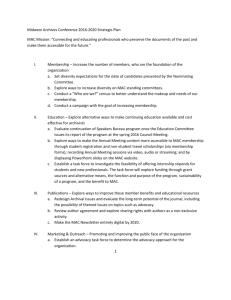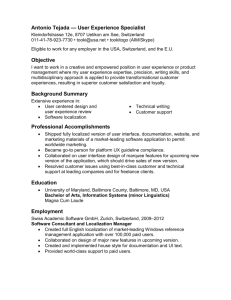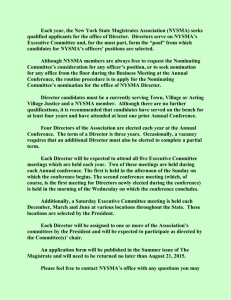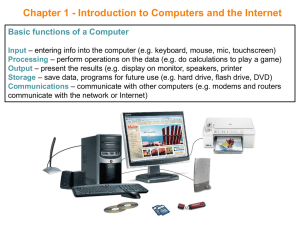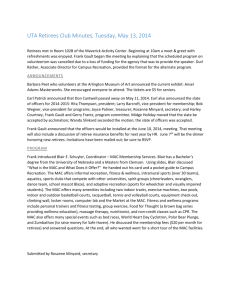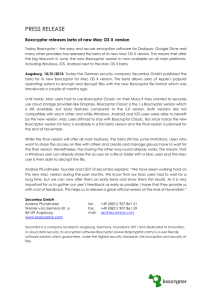Nominating Committee Membership White Paper
advertisement
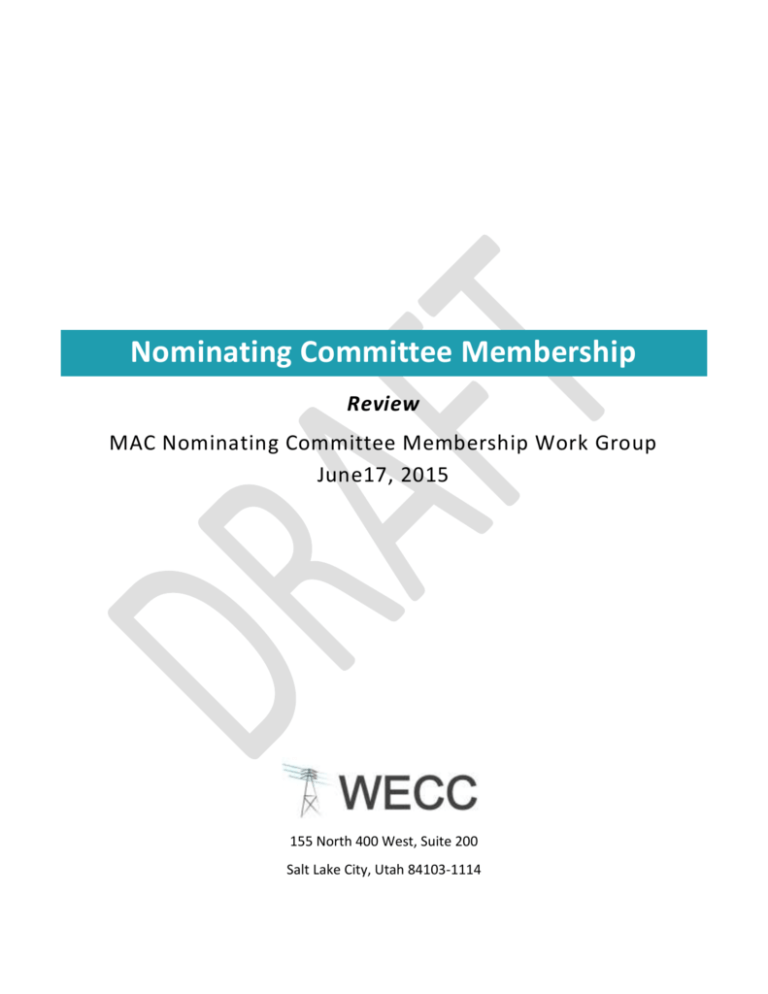
Nominating Committee Membership Review MAC Nominating Committee Membership Work Group June17, 2015 155 North 400 West, Suite 200 Salt Lake City, Utah 84103-1114 Nominating Committee Membership Review i Executive Summary To Follow W E S T E R N E L E C T R I C I T Y C O O R D I N A T I N G C O U N C I L Nominating Committee Membership Review ii Table of Contents Introduction...................................................................................................................................... 1 Ideal State ........................................................................................................................................ 1 Problem ............................................................................................................................................ 1 Work Plan ......................................................................................................................................... 2 Understand the History (March & April 2015) ....................................................................................... 2 Identification of Structures (May 15, 2015)............................................................................................ 2 Prepare Whitepaper & Draft Recommendation (May 16, 2015 – June 15, 2015) ................................. 2 Obtain MAC approval to issue Whitepaper & Draft Recommendation (June 23, 2015) ....................... 2 Socialize Options (June 24, 2015 – July 22, 2015) .................................................................................. 2 Identify Structure to Recommend (July 23, 2015 – August 10, 2015).................................................... 2 Recommend Structure (August 19, 2015 MAC Meeting) ....................................................................... 2 Present Approved Recommendation to Section 4.9 Review Working Group and Board (September 2, 2015) ....................................................................................................................................................... 2 Develop alternative strategies - Identification of Solutions ................................................................ 3 1. Status Quo - Three Directors and Four MAC Members ..................................................................... 3 2. & 3. Maintaining Voting Balance ....................................................................................................... 3 4. & 5. Expanded MAC Member Rotation ............................................................................................. 3 6. Reduced NC Size ................................................................................................................................. 3 7. No MAC Representation on NC.......................................................................................................... 3 Comparison of NC Structures (Table) ................................................................................................. 4 Further Discussion ............................................................................................................................ 5 Existing Bylaws ........................................................................................................................................ 5 Status Quo - Three Directors and Four MAC Members .......................................................................... 5 Why Change? .......................................................................................................................................... 5 The Options ............................................................................................................................................. 6 MAC Input ............................................................................................................................................... 6 Membership Views ................................................................................................................................. 7 Recommendation (Draft) .................................................................................................................. 7 W E S T E R N E L E C T R I C I T Y C O O R D I N A T I N G C O U N C I L Nominating Committee Membership Review 1 Introduction The WECC Nominating Committee (“NC”) is delegated two major tasks under the WECC bylaws: determine a slate of Director candidates to be presented for election by the WECC Membership each year; and provide a recommendation annually with respect to Director compensation for approval by the Member Advisory Committee (“MAC”). The composition of the NC is defined by Section 6.4.1 of the WECC bylaws. The nominating committee is to consist of seven, three being Directors, not standing for re-election, and four being drawn from the MAC, two being from Classes 1, 2, and/or 3, and two being from Classes 4 and/or 5. Voting majority requirements for approval by the NC of either the slate of candidates or the compensation are defined by Sections 6.4.2.4 and 6.4.5 respectively. In both cases, a total of five votes are required for approval, ensuring that at least one Director and two MAC Members are included in an approval vote. The Nominating Committee Membership Work Group (“NCMWG”) was formed by the MAC to review whether a change in the NC membership should be considered and, if so, identify what modifications might be necessary within Section 6 of the bylaws to make such a change. While the NCMWG’s timeline is designed to meet reporting milestones at certain MAC and Board meetings, it should be noted that the review of the NC Membership by the NCMWG is NOT part of the wider 4.9 Review being carried out by WECC. Ideal State The NC should be sufficiently large to ensure that substantive debate occurs but small enough to be manageable, both during deliberation and during any candidate interview process. The NC should be perceived to be representative of the membership interests. Its composition, therefore, should be inclusive and balanced to ensure that the slate of candidates nominated are diverse in knowledge, background and skills and that together with the incumbent Board Directors will create a Board that meets the intent of the requirements of Section 6.2 of the WECC bylaws with respect to Board Member qualifications. Balanced participation should be maintained in a number of areas such as incumbent Directors versus MAC Members, electric line of business companies versus customers, and regulators and other interested parties. Problem Some concern has been expressed by the WECC membership and by some MAC Members that at least one member class (1, 2 or 3) is excluded from the process on an annual rotating basis and that this perceived inequity is compounded by the recent addition of the international presence on the MAC. W E S T E R N E L E C T R I C I T Y C O O R D I N A T I N G C O U N C I L Nominating Committee Membership Review 2 While the international members are represented by their membership class, they do not have opportunity to present a separate international voice. Work Plan Understand the History (March & April 2015) The composition of the NC was the subject of considerable discussion during the WECC bifurcation process. As a starting point, collect and assess all available information pertaining to those discussions. Identification of Structures (May 15, 2015) NCMWG to identify and tabulate, with pros and cons, a series of possible structures for the NC that approach the Ideal State. Prepare Whitepaper & Draft Recommendation (May 16, 2015 – June 15, 2015) NCMWG to prepare Whitepaper identifying options and providing a draft recommendation. Whitepaper to be used to seek membership input. Obtain MAC approval to issue Whitepaper & Draft Recommendation (June 23, 2015) MAC to review and approve Whitepaper for use in membership comment period. Socialize Options (June 24, 2015 – July 22, 2015) NCMWG to publish Whitepaper identifying options being considered and a draft recommendation, for membership input. Identify Structure to Recommend (July 23, 2015 – August 10, 2015) NCMWG to collate any input received, determine preferred NC structure and prepare final recommendation for MAC consideration. Recommend Structure (August 19, 2015 MAC Meeting) NCMWG to bring recommendation to MAC for review and approval. Present Approved Recommendation to Section 4.9 Review Working Group and Board (September 2, 2015) Present recommendation to Board. W E S T E R N E L E C T R I C I T Y C O O R D I N A T I N G C O U N C I L Nominating Committee Membership Review 3 Develop alternative strategies - Identification of Solutions The NCMWG has identified a range of NC structures that might address the problem. It is acknowledged that the NC appears to have operated effectively since bifurcation despite this perceived inequity and therefore the status quo was considered as one end of the spectrum. At the other end of the spectrum, the NCMWG considered a Director only NC to represent independence and to mirror the nomination process used by some large utilities. 1. Status Quo - Three Directors and Four MAC Members Three Directors plus two MAC Members selected from Classes 1, 2 & 3 and one MAC Member from each of Class 4 and Class 5. 2. & 3. Maintaining Voting Balance Six MAC Members, one selected from each Class and one from International plus either: Three Directors - MAC Members have proportional vote to maintain existing balance Five Directors – all NC members have a single vote 4. & 5. Expanded MAC Member Rotation Three Directors plus four MAC Members, with MAC Members selected by either: Two MAC Members rotated between Classes 1, 2 & 3 and Two MAC Members rotated between Classes 4 & 5 and International Four MAC Members rotated between Classes 1 through 5 and International 6. Reduced NC Size One Director plus two MAC Members, with one MAC Member representing Industry and one representing non-industry interests. 7. No MAC Representation on NC Three or more Directors only. Further discussion of these Options is presented in the following Sections. W E S T E R N E L E C T R I C I T Y C O O R D I N A T I N G C O U N C I L Nominating Committee Membership Review 4 Comparison of NC Structures (Table) Option Description By-Law Change 1 Status quo; no changes made to the current process No Pros 2&3 Six MAC representatives (Classes 1 through 5 plus International) plus: Yes Either Option 2 Voting & Members Three Board representatives MAC reps with fractional vote to maintain existing balance with Directors. 4&5 Easy to implement Manageable size International members are represented through their classes 1 – 5 The process resulted in candidates that were ratified and elected by WECC members Each Class and International has a vote, aligning with MAC membership and reflecting comparability and equitability Maintains existing balance with Directors. Option 2 does not increase Director representation on the NC Expanded involvement in review of candidates Additional input into the process is recognized Five Board representatives All representatives one vote Four MAC representatives and Three Board representatives with: Yes Either Option 4 Or Option 3 Cons Members only Classes 1, 2 and 3 share two seats Classes 4&5 and International share two seats. Or Option 5 The classes are treated comparably and equitably, rotating representation on the NC – two seats for three Classes or four seats for five Classes and International The International Members represent more than industry and have responsibilities to all the stakeholders in their countries; it may be reasonable to have them included with Classes 4 and 5 Does not change the composition of the Nominating Committee Perceived as in-equitable o One of the Classes 1, 2 or 3 is disenfranchised every three years, o No specific representation is provided for International members Revision to the bylaws to include International representation on the Nominating Committee and either fractional voting or possible additional Directors o Fractional vote for Option 2, Unequal individual votes could lead to unbalanced discussion and possible “intimidation” or other unintended consequences For Option 3, additional Directors may mean additional expense Additional people (two or four) involved in the decision making and interview process. o On rotational basis, two classes could defer involvement in interview Revision to the bylaws to include International representation on the Nominating Committee and identifying: o either sharing of two seats by Classes 4, 5 and International o or rotation of the existing 4 seats between the 5 Classes and International 6 Classes 1-5 and International share four seats with equitable rotation. Two MAC representatives and Three Board representatives One representative from industry and one representative from non-industry Consider reducing Board Representation also Yes Voting & Members Equal representation afforded to industry and nonindustry classes Potentially reduces the number of MAC and Director representatives on the Nominating Committee to two MAC and one Director rather than four and three (if acceptable to Board) 7 Nominating Committee comprised entirely of incumbent Board directors Yes Members only W E S T E R N E Avoids the question of how Classes are represented in the NC process, and allows membership to be on an equal footing Membership still has ultimate veto ability during the annual-meeting process May be more appropriate for a Board whose independence is a vital characteristic L E C T R I C I T Y C O O R D I N A T I N G Revision to the bylaws to reduce NC membership and potentially define rotation of seats between Classes and International Creates more disparity since Classes 1, 2 & 3 would share seat and Classes 4 & 5 would share a seat. Unclear whether International would be industry or nonindustry and which seat it would share Reduced NC size could lead to insufficient discussion to aid best candidate selection Could create a disconnection between the Board and Members. Removing MAC involvement also removes the ability of a subset of MAC to endorse the slate of candidates and assist in the election. C O U N C I L Nominating Committee Membership Review 5 Further Discussion The process that the NCMWG is following has been structured to ensure that membership comment is actively sought prior to finalizing any recommendation. However in developing the initial draft of this white paper, only limited outreach has been performed. The opinions relating to the current situation and the options being considered are therefore primarily the opinions of the members of the NCMWG. Existing Bylaws The bylaws pertaining to the make-up of the NC are: 6.4.1 - Nominating Committee. Candidates for a Director position shall be nominated by a Nominating Committee. The Nominating Committee shall consist of seven members. Three members shall be Directors, not standing for re-election, designated by the Board Chair. The remaining four Nominating Committee members shall be designated by the Member Advisory Committee and come from individuals serving on the Member Advisory Committee, with two (2) members being from Classes 1, 2, and/or 3, and two (2) members being from Classes 4 and/or 5. 6.4.2.4 Five (5) affirmative votes of the Nominating Committee shall be necessary to put forth a nominee to the Members. Status Quo - Three Directors and Four MAC Members The NC, as currently defined in the bylaws (three Directors plus two MAC Members selected from Classes 1, 2 & 3 and one MAC Member from each of Class 4 and Class 5) has carried out one candidate selection process and is in the midst of a second. Based on the outcome of the 2014 process, the NC identified highly qualified candidates, using an effective and time appropriate process. The identified candidates proved to be acceptable to the membership at large, being elected to the Board by a substantial majority vote from all Classes, including by the membership of Classes not then currently represented on the NC. The resulting Board has been appropriately diverse in background and opinion and has represented the interest of the organization and membership. The NC has also overseen a review of Director compensation, producing a recommendation that was approved by the MAC by a substantial margin. Why Change? There is a perception that the current structure is not inclusive and that the initials steps of the selection process, or compensation review, specifically exclude the collective international viewpoint (although international members views are represented in their individual classes) and either Class 1, 2 or 3 on a rotating basis. While the limited history of operating under the current structure does not indicate that it leads to a result that is unacceptable to the excluded class(es), it may in the future. W E S T E R N E L E C T R I C I T Y C O O R D I N A T I N G C O U N C I L Nominating Committee Membership Review 6 The Options The NCMWG has reached consensus that options that permanently exclude representation from any of the Classes are not going to be acceptable to the membership – this leads to the rejection of Options 6 & 7. The NCMWG has also reached consensus that the existing balance between Board and MAC representation (and/or voting strength) on the NC is appropriate and should be preserved. The majority opinion of the NCMWG is that increasing the size of the NC is an undesirable outcome, and there is a clear preference to retain the status quo, with either Option 4 or Option 5 as the alternate, further evaluation and discussion being needed before deciding between these two options if necessary. This majority opinion conflicts with the minority opinion that all classes (plus an international voice) should be represented on the NC at all times. As it stands today, without soliciting specific input from the membership, the NCMWG recommendation to the MAC and ultimately to the WECC membership would be that no adjustment be made to the membership of the NC, or the bylaws that govern the selection of NC members. Clearly this would be a majority recommendation and not a consensus recommendation. MAC Input The NCMWG believes that prior to providing a final version of this whitepaper to the membership seeking their input, we need to solicit input from the full MAC at the forthcoming in-person June MAC meeting and potentially adjust the whitepaper accordingly. W E S T E R N E L E C T R I C I T Y C O O R D I N A T I N G C O U N C I L Nominating Committee Membership Review 7 Membership Views Further update anticipated after MAC and/or Member comments received to the following questions: The Nominating Committee Membership Working Group recommends maintaining the current makeup of the Nominating Committee, but are seeking Member input: Do you favor retaining the current make-up of the Nominating Committee, i.e. Three Directors and Four MAC Members (Two MAC Members selected from Classes 1, 2 & 3 and one MAC Member from each of Class 4 and Class 5, no separate international representation) for a period of two years with a further review of the effectiveness of the committee at some stage after that? Or Do you support the MAC recommending a change to the structure to Three Directors and Six MAC Members (one MAC Member from Classes 1 through 5 plus International) with an appropriate adjustment to the majority voting requirements to maintain the current balance between Board and MAC? Or Do you wish other options further considered before finalizing the recommendation? Recommendation (Draft) To be further refined following MAC and/or Member comments received. Assuming nothing changes The NCMWG recommends that: The current make-up of the Nominating Committee, i.e. Three Directors and Four MAC Members (Two MAC Members selected from Classes 1, 2 & 3 and one MAC Member from each of Class 4 and Class 5, no separate international representation) be retained; and A further review of the effectiveness of the Nominating Committee and its make-up be performed after the Nominating Committee membership has cycled through all classes in approximately two years, if necessary. W E S T E R N E L E C T R I C I T Y C O O R D I N A T I N G C O U N C I L Nominating Committee Membership Review 8 Disclaimer WECC receives data used in its analyses from a wide variety of sources. WECC strives to source its data from reliable entities and undertakes reasonable efforts to validate the accuracy of the data used. WECC believes the data contained herein and used in its analyses is accurate and reliable. However, WECC disclaims any and all representations, guarantees, warranties, and liability for the information contained herein and any use thereof. Persons who use and rely on the information contained herein do so at their own risk. W E S T E R N E L E C T R I C I T Y C O O R D I N A T I N G C O U N C I L
